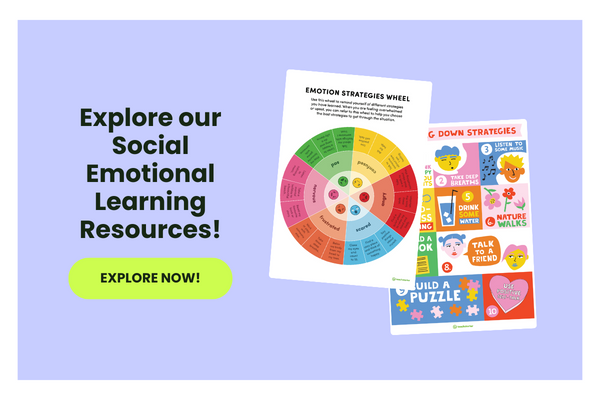In the early years of a child’s development, separation anxiety is fairly common when kids are away from their parents or carers, and it’s especially common at school for younger children. Humble classroom doors everywhere have borne witness to countless crying children (understandably) distressed by their impending separation from their beloved parents. But what can teachers do to ease their students’ back-to-school separation anxiety and make those morning goodbyes more pleasant — especially for those Foundation or Prep students who may be starting school for the very first time?
The teachers on the Teach Starter team have put their heads together and created this list of tips to make separation anxiety fade away and students’ transition into the classroom easier for everyone! Read on for a look at what causes separation anxiety and how you can help both your students and their parents.
What Is Separation Anxiety?
Early Childhood Australia states that ‘separation anxiety ‘can occur when a child gets upset when separated from a parent or carer.’
Usually rearing its ugly head in infancy around 7 or 8 months, which is when babies start to grasp the concept of object permanence (the understanding that objects continue to exist even when they can’t be seen or heard), separation anxiety can crop up when dropping a child off at childcare or even with someone familiar such as a grandparent or close friend. It can subside only to pop up again when children begin Prep, making back-to-school mornings rough on students, parents, and teachers.
The good news? In young children (from infancy to around age 5), separation anxiety is considered a normal part of childhood development, and in most cases it will resolve over time.
Separation anxiety in lower years may present as crying, tantrums, or clinginess, and these are all healthy reactions for a child to have when separating from a loved one. As teachers, it’s a good idea to have a bag of tricks to help our students settle into our classrooms so that they can have productive and enjoyable learning experiences.
How to Deal With Children With Symptoms of Separation Anxiety
With some simple strategies, parents and teachers can work together to help children overcome separation anxiety.
Introduce Yourself Ahead of Time
For many students, the first day of school is the very first time they will meet you face-to-face, and that can be scary. If your state doesn’t hold an open house before school begins for children to meet you, we suggest sending home a meet-the-teacher letter before the first day of school.
This will allow students to get to know a little bit about you to ease some of the ‘scary’ that comes with meeting a perfect stranger.
Acknowledge the Student’s Feelings
Get down to the student’s level and make eye contact, and let them know that it’s okay for them to feel upset. Remind the child that they are in a safe and secure place with kind and caring people (children and adults).
Acknowledge the Parents’ Feelings Too
Try to step into the parents’ shoes for a moment, because as a mum, dad or other carer, watching a child become distressed and then having to leave (often to face a day of work) is tremendously upsetting. Assure parents that you will help their child settle in and that their little one isn’t the first to have difficulty separating from them. Build rapport with the parents, which will help the child develop trust with you, too.
Be the Primary Point of Contact
Your anxious student needs to develop a sense of trust and a feeling of safety with you. Try to ensure that you, the classroom teacher, are consistently the person who greets any anxious little ones in your class in those early days of school. This will also help you get to know the parents and establish a routine and rhythm for the handover.
Give the Student a Special Role
Offer your worried student a very special helping role, like handing out glue sticks, setting out worksheets, dusting the board or being the ‘login’ helper at the computers.
Let Parents Know How You’ll Communicate
Sometimes, parents find it very hard to leave their child while they are still crying. If you can, reassure the parent that you’ll be in touch to update them (by email or phone call) during the break on the first day. Then establish a communication method that works for both of you moving forward..
Give one of these parent communication resources a try!
Minimise Morning Rush
Set up a routine that is calm and quiet for the arrival process. We’ve found that reading a story is a great way to get the children settled before doing attendance. For older students, individual desktop reading, drawing, or writing could be a calming option. Play some gentle music to encourage students to slow down. The morning rush to get to school can be overwhelming, and arriving at a peaceful space will be calming. Check out these routines to institute in the classroom to help with the transition.
Normalise the Feelings Associated with Separation Anxiety
As a whole class, read or view The Invisible String by Patrice Karst and Joanne Lew-Vriethoff, and facilitate a discussion about the special people children are separated from and the reasons why we may become separated from loved ones.
Offer the Student Activity Options
Once the student is in the door, show them options for different types of activities they may wish to do before the morning routine commences. This will help the child to focus on the mental task of decision-making and may break them from their loop of anxious thoughts that fuel their separation anxiety. Be sure to offer quiet or alone time as well, as some children will prefer to observe and adjust at their own pace.
Create a Visual Timetable for the Student
Having a visual timetable helps students with anxiety anticipate and plan for transitions and routines throughout their day. This could be something you offer for the whole class or just for your anxious student/s.
Older Children and Separation Anxiety
What about children who are still experiencing anxiety at the prospect of being away from their parents well into their school years? Well, while a little worry about leaving mum or dad when older is totally normal (like when they’re going on school camp), intense fear which keeps a child from experiencing and enjoying normal activities may be categorised as Separation Anxiety Disorder (SAD).
While the signs of SAD are similar to those of separation anxiety, they are more extreme and prolonged and may include:
- Excessive tiredness due to lack of sleep/nightmares about being alone
- Being worried when away from home or family (e.g. at school, care or after-school activities)
- Anxious about the safety of a particular family member
- Fear of becoming lost
- Refusing to go to school
- Fearful of being alone, even in safe environments (e.g. in a library aisle, in a bathroom stall)
- Frequent tummy aches, headaches, or other physical complaints
- Excessive worry about personal safety
- Panic resulting in temper tantrums, crying or lashing out at times of separation from parents
Separation Anxiety Disorder may require professional support. If you suspect that one of your students has signs of SAD, it’s important to talk to their parents and possibly refer them to a school counsellor or psychologist for additional support.











Comments